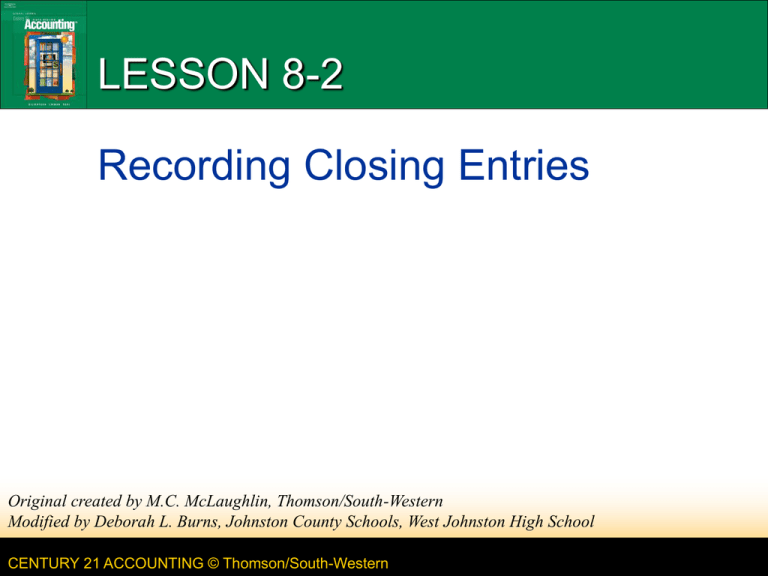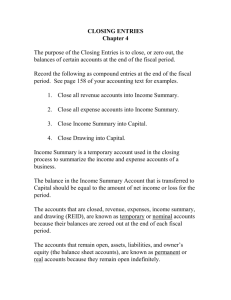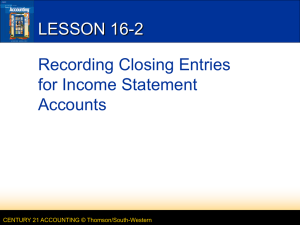2.03 PowerPoint 2
advertisement

LESSON 8-2 Recording Closing Entries Original created by M.C. McLaughlin, Thomson/South-Western Modified by Deborah L. Burns, Johnston County Schools, West Johnston High School CENTURY 21 ACCOUNTING © Thomson/South-Western 2 Permanent & Temporary Accounts Accounts used to accumulate information from one fiscal period to the next are called permanent accounts (also referred to as real accounts) Assets, Liabilities, Owner’s Equity Accounts used to accumulate information until it is transferred to the owner’s capital account are called temporary accounts (also referred to as nominal accounts) Revenue, Expense, Owner’s Drawing, Income Summary CENTURY 21 ACCOUNTING © Thomson/South-Western LESSON 8-2 3 NEED FOR CLOSING TEMPORARY ACCOUNTS page 207 Journal entries used to prepare temporary accounts for a new fiscal period are called closing entries Temporary account balances must be reduced to zero at the end of each fiscal period To close a temporary account, an amount equal to its balance is recorded in the account on the side opposite to its balance A temporary capital account titled Income Summary is used to summarize the closing entries for the revenue & expense accounts CENTURY 21 ACCOUNTING © Thomson/South-Western LESSON 8-2 4 NEED FOR THE INCOME SUMMARY ACCOUNT page 207 The income summary account is unique because it does not have a normal balance side The balance of this account is determined by the amounts posted to the account at the end of a fiscal period CENTURY 21 ACCOUNTING © Thomson/South-Western LESSON 8-2 5 NEED FOR THE INCOME SUMMARY ACCOUNT Business record four closing entries: An entry to close Income statement accounts with credit balances An entry to close income statement accounts with debit balances An entry to record net income or net loss and close Income Summary An entry to close the owner’s drawing account CENTURY 21 ACCOUNTING © Thomson/South-Western LESSON 8-2 6 CLOSING ENTRY FOR AN INCOME STATEMENT ACCOUNT WITH A CREDIT BALANCE page 208 (Debit to close) 1 2 3 4 1. Write the heading. 2. Write the date. 3. Write the title of the account debited. Record the debit amount. 4. Write the title of the account credited. Record the credit amount. CENTURY 21 ACCOUNTING © Thomson/South-Western LESSON 8-2 7 CLOSING ENTRY FOR INCOME STATEMENT ACCOUNTS WITH DEBIT BALANCES 1. 2. 3. 4. page 209 Date Income Summary Credit Debit amount (Credit to close) 1 2 4 3 CENTURY 21 ACCOUNTING © Thomson/South-Western LESSON 8-2 CLOSING ENTRY TO RECORD NET INCOME OR LOSS AND CLOSE THE INCOME SUMMARY ACCOUNT 8 page 210 1. Date 2. Debit 3. Credit (Capital: credit to record net income) (Income Summary: debit to close) 1 2 3 CENTURY 21 ACCOUNTING © Thomson/South-Western LESSON 8-2 9 CLOSING ENTRY FOR THE OWNER’S DRAWING ACCOUNT page 211 1. Date 2. Debit 3. Credit (Credit to close) 1 2 3 CENTURY 21 ACCOUNTING © Thomson/South-Western LESSON 8-2 10 TERMS REVIEW page 212 permanent accounts temporary accounts closing entries CENTURY 21 ACCOUNTING © Thomson/South-Western LESSON 8-2







